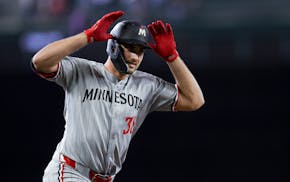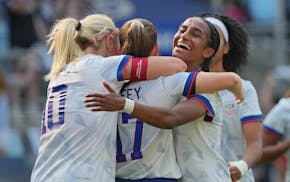Stan Kasten was told it would be impossible. Nuts, even. When he was given the task of creating a new women's pro hockey league — and a six-month timetable to bring it to life — he understood why so many people doubted it could be done.
"I never thought it was going to be fun," said Kasten, a longtime pro sports executive. "I thought it was going to be hard. But I thought it would be worthwhile."
The Professional Women's Hockey League turned out to be all those things. Its inaugural season ended last Wednesday, with PWHL Minnesota beating Boston in a thrilling five-game championship series to win the Walter Cup.
Kasten said he knew the PWHL was going to make it only a week into its first season. He came to Minnesota to watch the team's home opener at Xcel Energy Center, and a fired-up crowd announced at 13,316 proved the demand was there for a women's league showcasing the world's best players. All season long, the evidence kept pouring in.
The six-team league drew nearly 500,000 fans to its 85 games, including the regular season and playoffs. More than 40 corporate sponsors signed on. Its games were televised on many of the same networks that carry major men's sports, and its YouTube channel — which also shows games live — has more than 100,000 subscribers.
Season 1 and season 2 will soon cross paths in St. Paul, when the PWHL holds its draft June 10 and honors this year's award winners the next day. Team nicknames and logos are set to be revealed in August, just a few months before a 30-game regular-season schedule starts in November.
Kasten said the league's sole investors, Mark and Kimbra Walter, are "ecstatic" with the way the season went. So is everyone from players to team employees to PWHL officials.
"I don't think I could have envisioned this playing out the way it did," said Jayna Hefford, the PWHL's senior vice president of hockey operations. "The excitement around it, the response of our fans, the response from media. We're just thrilled with where it's at."
The league has not revealed any information about its finances. Kasten, a member of its advisory board, has said the PWHL has a 10-year business plan and does not expect to be profitable anytime soon. But nine days ago, he reiterated that Walter is "all in," committed to financing the PWHL over the long haul.
Walter is CEO of an investment firm and owner of several sports teams, including baseball's Los Angeles Dodgers. Kasten, the Dodgers president and CEO, said Walter supported a decision to spend more money than originally planned in the PWHL's first season.
The league invested heavily in some areas, such as producing major-league-quality broadcasts and expanding staffing. Kasten said its revenue exceeded projections, driven in part by the additional spending.
"That was a lot of expense we didn't expect right away," Kasten said. "But we said, 'You know what? We're all in.' So let's do Year 4 expenses in Year 1. And that resulted in a lot more revenue. The investments we made are paying off."
Kasten and Hefford said league officials will review every aspect of the season, looking for ways to improve. They want to get more teams into larger venues, including NHL arenas. PWHL Minnesota was the only team that regularly played home games in an NHL arena this season.
A pair of Montreal-Toronto games were played at NHL venues, drawing 19,285 in Toronto's Scotiabank Arena and 21,105 — a women's pro record — in Montreal's Bell Centre. The league also expects to hold more games at neutral sites. NHL arenas in Detroit and Pittsburgh hosted PWHL games this season, an experiment Kasten called "wildly successful."
Fans should find more merchandise next season, both in quantity and variety. Production of team swag started late this season because of the rushed timeline, but Kasten said the league "sold everything we could make."
Some of the new gear will have the nicknames and logos that are introduced this summer. The names used this year, with PWHL followed by the team's home city or state, became popular and will also be used.
The league does plan to expand, though not in the near future. With only 156 roster spots available league-wide, Hefford said a top priority is to find a pathway to develop players who don't make PWHL rosters. "Many, many people want to find a solution," she said. "We want to keep more women playing."
All of that adds up to a very long to-do list for the offseason. But after achieving what some said was impossible, the league's leaders are energized.
"As exciting as this is for all of us, we can't wait to get started on Year 2," Kasten said. "We know with all summer to prepare, it's going to be even better."

Wallner activated from IL, giving Twins a nearly fully healthy roster

USWNT shuts out China 3-0 at Allianz Field

Reusse: Murphy's return will be a fun time on the ice

Analysis: The Wolves' offseason, broken down for easy consumption of a complicated topic
